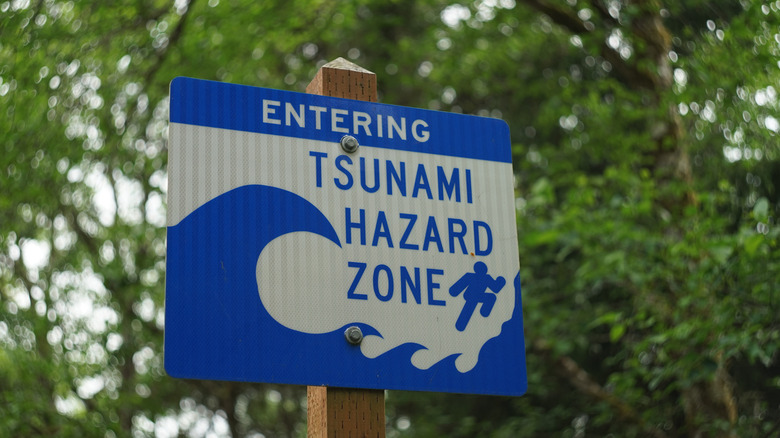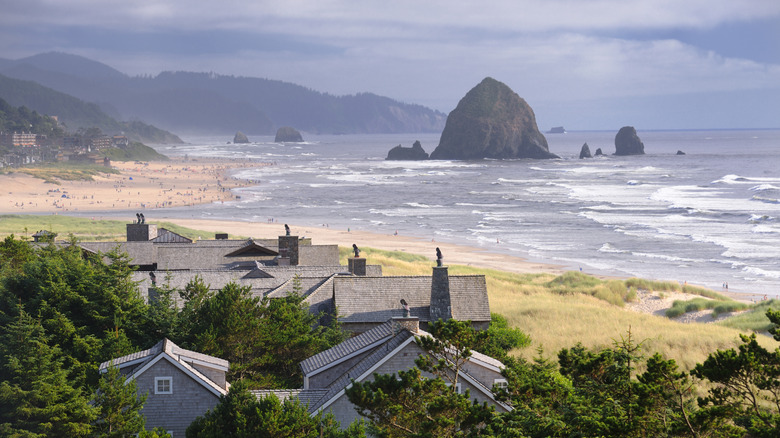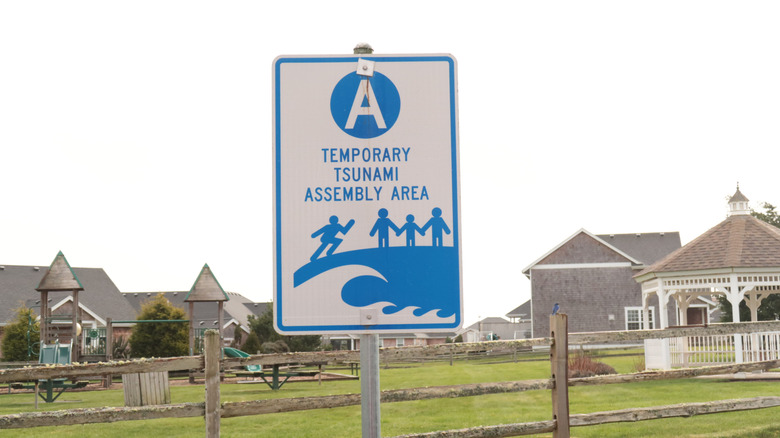Here's What You Need To Know About The Scary Tsunami Evacuation Signs That Are All Over Oregon's Coast
Few things interrupt the blissful calm of vacation mindset like coming face to face with a tsunami evacuation sign during your beach getaway. A desperate stick figure scrambles up an incline as a towering wave barrels forward, while "Tsunami Hazard Zone" appears in unmissable letters. Along the Oregon Coast, you'll find these signs (and many others like them) in abundance.
These signs are part of Tsunami Outreach Oregon, a community-driven program aimed to raise awareness about tsunami and earthquake safety and increase survival odds in the event of a tsunami. Signs identify streets within the tsunami inundation zone and roads leading to safe areas or mass gathering points. And, while it's unlikely a tsunami will impact your next vacation at Cannon Beach or another Oregon coastal playground, it's important to be prepared and know the risks.
The Oregon Coast is prone to tsunamis due to its location along the Cascadia Subduction Zone (CSZ), a 700-mile-long "megathrust" fault that runs offshore from British Columbia to northern California. Most of the time, tectonic plates move incredibly slowly and harmlessly, but every once in a while they become stuck, releasing a massive amount of energy in the form of an earthquake when they break free. When this happens along a seafloor, it can then trigger a tsunami. The more stress and tension accumulate along the Cascadia Subduction Zone, the larger the earthquake and tsunami will be.
How common are tsunamis in Oregon?
Oregon has a 37% chance of experiencing an earthquake of 7.1 magnitude or greater and a subsequent tsunami sometime in the next 50 years, according to the Oregon Department of Emergency Management. If an earthquake originating in the Cascadia Subduction Zone reached a magnitude of 9.0 or greater, the resulting 100-foot tsunami would likely hit the Oregon Coast within just 15 to 20 minutes.
The last major earthquake along the Cascadia Subduction Zone occurred in 1700 with a devastating magnitude of 9.0. Indigenous oral history published in 2005 in Seismological Research Letters describes massive saltwater flooding and a force so strong "people could neither stand nor sit for the extreme motion of the earth." There's no precise record of how many people died in the earthquake of 1700, but the devastation was extensive. "The next one might not be for another 100 years or even 200 years," Ed Nissen, a researcher at the University of Victoria, told CTVNews. "But it's also true to say it could happen tomorrow."
The type of tsunami caused by the Cascadia Subduction Zone or another nearby fault is defined as "local" due to the earthquake's close proximity. However, Oregon can also experience "distant" tsunamis, which travel across the ocean and give people more time to escape. For instance, in 1964, a magnitude 9.2 earthquake occurred in Alaska, causing a tsunami to race across the ocean at 500 mph before inundating Cannon Beach and other coastal communities.
How to keep yourself safe during a tsunami on the Oregon Coast
Although a tsunami is a terrifying prospect, there are steps you can take to keep yourself safe. If you're a coastal Oregon visitor, identify the nearest tsunami escape route (those posted signs can come in handy for this) and consider staying at a hotel on higher ground. After an earthquake, immediately follow the evacuation route to a place at least 100 feet above sea level. In the event of a "local" tsunami, you may not receive the National Weather Service (NOAA)'s tsunami notifications before the wave hits. If you feel shaking, that's a signal to evacuate the beach immediately. In addition, if the ocean suddenly retreats while you're at the beach, immediately seek higher ground and never enter the water.
Tsunami Outreach Oregon's signs are just a small part of a greater plan to prepare and educate residents and visitors. In addition, the state has conducted risk assessments of beach towns and provides detailed, interactive tsunami evacuation maps. For instance, you can use these maps to determine that Tillamook, a coastal Oregon city with famous cheese, has a downtown almost entirely outside the tsunami evacuation zone.
In addition, the Oregon State University Extension program offers a free online course called "Preparing for the Cascadia Subduction Zone Event" with four modules designed to increase disaster preparedness. Although it might not be as exciting as the California Academy of Sciences' exhibit where visitors can experience San Francisco's most violent earthquakes safely, 97% of students in a survey found the course helpful.


